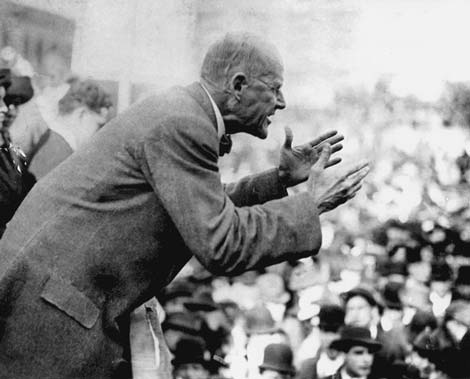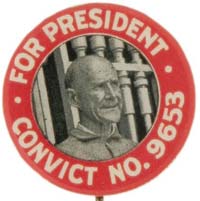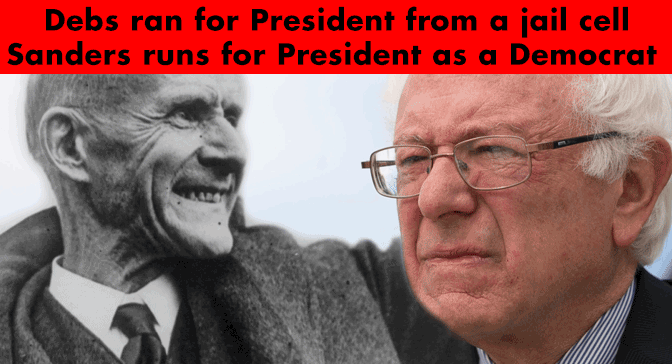Socialist Worker
May 26, 2015
by Howie Hawkins
BERNIE SANDERS’ entry into the Democratic presidential primaries should be seen as his final decisive step away from the democratic socialism he professes to support. He will raise some progressive demands in the primaries and then endorse the corporate Democrat, Hillary Clinton. Nothing changes.
Sanders is violating the first principle of socialist politics: class independence. The socialist movement learned that principle long ago when the business classes sold out the workers in the democratic revolutions of 1848 that swept across Europe and parts of Latin America.
Drawing out the lesson from these failed revolutions that the middle class proprietors and professionals could not be trusted as allies of the workers in the battle for democracy and workers rights, Karl Marx told exiled German revolutionaries in London in 1850 that the workers needed to form their own party to look out for their own interests:
Even where there is no prospect whatsoever of them being elected, the workers must put up their own candidates in order to preserve their independence, to count their forces and to bring before the public their own revolutionary attitude and party standpoint. In this connection, they must not allow themselves to be seduced by such arguments as, for example, that by so doing they are splitting the Democratic Party and making it possible for the reactionaries to win. The ultimate intention of all such phrases is to dupe the proletariat. The advance which the proletarian party is bound to make by such independent action is infinitely more important than the disadvantages that might be incurred by the presence of a few reactionaries in the representative body.
The Democratic Party that Marx was referring to in his 1850 speech was the most pro-democracy of the German parties based in the business and professional classes, which were fighting for universal suffrage against the ruling feudal landed aristocracy, but stopped fighting for workers’ rights once propertied men had the vote. But the argument applies just as well to the Democratic Party in the U.S. today–a party that poses as the champion of working people, but serves business interests.
Sanders has now gone into coalition with the billionaire class he professes to oppose and that finances the Democratic party. Sanders won’t see the billionaire’s money. But he has made it crystal clear that he will support their candidate by promising to support the winner of the Democratic presidential nomination.
UNFORTUNATELY, TOO many self-professed socialists in the U.S. have abandoned the socialist principle of independent political action. They argue instead that whether or not to support a Democrat or an independent candidate is a question of tactics, not principle.
That was not the case when the United States had a viable Socialist Party. The political independence of the Socialist Party is a major reason why it was viable, why it had power, why it elected many of its candidates, why it was central to the political dialogue of the country. After the demoralizing and self-defeating experience of fusion (cross-endorsing the more progressive Democratic and Republican candidates) that undermined and ultimately destroyed the Greenback Labor and People’s Parties of the recently past Populist era, the Socialist Party of America put into its constitution a ban against endorsing the candidates of the capitalist parties.
 `In his opening campaign speech as the party’s 1904 presidential candidate, Eugene Debs said:
`In his opening campaign speech as the party’s 1904 presidential candidate, Eugene Debs said:
The Republican and Democratic parties, or, to be more exact, the Republican-Democratic party, represent the capitalist class in the class struggle. They are the political wings of the capitalist system and such differences as arise between them relate to spoils and not to principles. With either of those parties in power, one thing is always certain, and that is that the capitalist class is in the saddle and the working class under the saddle.
 As a candidate for the Democratic presidential nomination, Sanders does a disservice to Debs’ memory and his commitment to working class political independence by displaying a Debs portrait in his office. By choosing to run for president in the Democratic primary, Bernie Sanders has shown he is no Eugene Debs.
As a candidate for the Democratic presidential nomination, Sanders does a disservice to Debs’ memory and his commitment to working class political independence by displaying a Debs portrait in his office. By choosing to run for president in the Democratic primary, Bernie Sanders has shown he is no Eugene Debs.
Sanders is confusing people about what socialism is. Socialism is not so much a social theory, a platform of policies or social ownership of the means of production. Socialism is, above all, the movement of the working class for their own freedom and power in a full democracy.
Sanders’ policies are pretty good on working class economic justice demands and climate action, and not so good on foreign policy and militarism. But his positions on the issues is secondary to the question of whether his politics are helping the working class act for itself or subsume itself under the big business interests in charge of the Democratic Party. By entering the Democratic primaries with the promise of supporting Clinton as the lesser evil to the Republicans, Sanders is not helping the working class to organize, speak and act for itself.
As Frederick Engels told socialists in the U.S. when the labor movement in New York City nominated the non-socialist but progressive reformer Henry George for mayor in 1886:
The first great step of importance for every country newly entering into the movement is always the organization of the workers as an independent political party, no matter how, so long as it is a distinct workers’ party. And this step has been taken, far more rapidly than we had a right to hope, and that is the main thing. That the first program of this party is still confused and highly deficient, that it has set up the banner of Henry George, these are inevitable evils but also only transitory ones. The masses must have time and opportunity to develop, and they can only have the opportunity when they have their own movement–no matter in what form, so long as it is only their own movement–in which they are driven further by their own mistakes and learn wisdom by hurting themselves.
THE INDEPENDENT left was a force to be reckoned with in U.S. politics from the 1840s through the 1930s. The Liberty Party, the Free Soil Party and the Radical Republicans carried the banners of abolition, land reform, labor rights and Reconstruction from the 1840s through 1870s. With the post-Civil War industrialization and rapid expansion of industrial workers, the surviving radicals of the pre-war reform movements formed the populist farmer-labor Greenback Labor and People’s Parties of the 1880s and 1890s.
With collapse of Populism into the Democratic Party, its radicals were central to the formation of the Socialist Party of America, as well as regionally based Labor, Farmer-Labor and Progressive Parties between 1900 and 1936, which came close to establishing a major third party on the left with a farmer-labor popular base. Together, they elected hundreds of local officials, scores of state officials and dozens of members of Congress. The Farmer-Labor and Progressive parties of the Upper Midwest in the 1930s had two governors, three U.S. Senators, 12 members of the House, and scores of state and local elected officials.
Those successes fueled widespread agitation for an independent labor party based on unions, which reached a peak as the 1936 election approached. Unfortunately, the unions and the Communist Party’s Popular Front policy led most of labor and the left into the Democratic Party’s New Deal Coalition in 1936–from which they never emerged afterward in a major way.
By failing to act on its own and speak for itself in U.S. elections, the left committed political suicide. It lost its independent voice and its platform from which to be heard. The public doesn’t hear from the left in elections. They only hear from pro-capitalist Democrats, who most of “the left” promotes as the lesser evil to the Republicans.
By trying to get Democratic politicians to say and do what the left wants them to say and do, the left has been engaged in a pathetic and hopeless attempt at political ventriloquism. It is dependent politics, powerless politics. It has been 80 years–20 presidential election cycles–since the left largely disappeared itself into the Democratic Party. It is way past time to draw the lesson of this experience: the left won’t regain power and public significance until it breaks with the Democrats and acts independently for itself.
SANDERS HAS attracted significant money and energy from progressives. In the first 24 hours after his announcement, his campaign reported raising $1.5 million from 35,000 donors and signing up over 100,000 volunteers. So the independent left is now debating how to relate to the Sanders campaign.
Some argue that we should just build movements outside the electoral arena for now, and that when they get big enough, an independent left party will emerge from them. Social movements making demands on the system are simply lobbying the Democrats in the absence of an independent left electoral alternative. An independent left party is needed so the Democrats are forced to respond to movement demands or lose votes to the left. Movements ebb and flow. A party is needed to keep activists organized and engaged during the downturns in social movements and provide organized support and perspectives when movements expand.
Some even argue that the Sanders campaign is a movement. We’ve heard that claim before with the candidacies of Jesse Jackson, Al Sharpton, Dennis Kucinich and Barack Obama. Bruce Dixon of Black Agenda Report aptly described these candidates as “sheepdogs…charged with herding activists and voters back into the Democratic fold who might otherwise drift leftward and outside of the Democratic party.”
No self-activating movements or organizations came out of these campaigns, and there is no reason to expect the Sanders campaign will be any different. The Sanders campaign is enlisting people in an election campaign, not an ongoing political organization. The Sanders campaign may be a bridge for some to positions as Democratic operatives, as it was for some in previous sheepdog campaigns. But it is not building a political organization that is independent and opposed to the capitalist parties.
The group Socialist Alternative has welcomed Sanders’ Democratic candidacy, while calling on him to continue running as an independent after the Democratic primaries. Socialist Alternative’s position is naïve at best–or worse, deliberately misleading. There is no way that Sanders will break with the Democrats on the presidential race. We should take him at his word: he’s backing the Democratic candidate. Sanders has a long record of supporting Democrats for president, including Gore, Kerry, and Obama, while harshly criticizing independent challengers on the left like Ralph Nader.
It’s one thing to tell Sanders supporters they need a Plan B–an independent left candidate–when he loses the primaries. It’s another to spread illusions that Sanders can be persuaded to be that candidate.
If Sanders wanted to do it, he would have paid petitioners out now getting him independent ballot lines in the 50 states and D.C. He doesn’t, and he won’t. If he did, the Democrats would bar him from the debates and primary ballots for being disloyal to the Democrats. Some states, such as Michigan, have sore-loser provisions that would prevent him from running as an independent after running as a Democrat. It’s disappointing to see Socialist Alternative spread illusions that Sanders will ever break with Clinton after the primaries, or that he even could do so as a practical matter of getting on the ballot.
From an independent socialist point of view, all the money and time going into Sanders’ handoff to Clinton is time and money that could be going into getting Jill Stein’s Green Party candidacy on every ballot in the country–the only independent left campaign in 2016 with any prospect for doing so. The Greens have 21 ballot lines already and most of the rest can be secured by petitioning in 2015. Doing so now would leave 2016 for campaigning.
One of the weaknesses of recent independent campaigns by Ralph Nader and the Greens is that the ballot access drive did not really begin until the year of the election, making the campaign mostly a desperate scramble to simply get on the ballot. With most ballot lines secured in 2015, the campaign could focus in 2016 on broadcasting its message and on field organizing to build local organizations, register new voters, identify supporting voters, pull them to the polls on Election Day, and continue after the election with local movement and electoral activity.
THE INDEPENDENT left should be talking to progressives who have decided to support Sanders. We should talk about why independent politics is the best way to build progressive power, about the Democratic Party as the historic graveyard of progressive movements, and about the need in 2016 for a progressive alternative when Sanders folds and endorses Clinton. I don’t expect many will be persuaded to quit the Sanders campaign before the primaries. But I do expect that many of them will want a Plan B, a progressive alternative to Clinton, after the primaries.
I had a similar scenario develop in during my 2014 Green Party campaign for governor of New York. Zephyr Teachout, a liberal Democrat running a primary challenge against the more conservative Democratic incumbent Andrew Cuomo, attracted the support of progressives in the Democratic Party and won a respectable 34 percent of the primary vote. Analysis of the general election results shows that about half of Teachout’s vote came to the Greens in the general election, and that it constituted about half of the Green vote. Our 5 percent showing was the best ever in New York for an independent left candidate for governor, except for the Socialists, who received 5.7 percent in 1918 and 5.6 percent in 1920.
If Stein’s Green campaign can draw a significant segment of Sanders supporters to it after the primaries, it could help the Green Party to make a quantum leap in the vote it receives in 2016 over previous elections. That would provide momentum for local, state and congressional elections in the coming years.
While the Debsian Socialists of a century ago were clear about their independence from the Democratic Party, they were also clear about wanting to draw progressives in the Democratic Party into the Socialist Party. As Debs stated in that same 1904 opening campaign speech quoted above:
Where but to the Socialist Party can these progressive people turn? They are now without a party and the only genuine Democratic Party in the field is the Socialist Party, and every true Democrat should thank Wall Street for driving him out of a party that is democratic in name only, and into one that is democratic in fact.
Progressives in the Democratic Party are going to need a Plan B after Bernie Sanders throws his support to Clinton in about 10 months, after the March primaries seal the nomination for her. We should be building Plan B now.
Howie Hawkins is a veteran activist, working Teamster and leader of the Green Party nationally and in his home state of New York. Last November, his campaign for governor against incumbent Democrat Andrew Cuomo won 200,000 votes, nearly 5 percent of the total–the most successful left-wing independent campaign in New York in more than 50 years.
Here, Hawkins contributes to the discussion on the left about the Bernie Sanders campaign for the Democratic Party presidential nomination.
